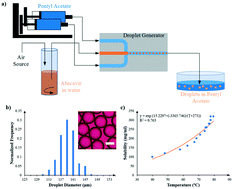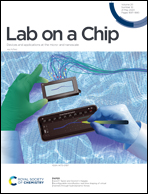Seeded droplet microfluidic system for small molecule crystallization†
Abstract
A microfluidic approach to seeded crystallization has been demonstrated using abacavir hemisulfate, a nucleoside analog reverse transcriptase inhibitor, in droplet reactors to control polymorphism and produce particles with a low particle size distribution. Two techniques are introduced: (1) the first technique involves an emulsion system consisting of a dispersed phase solvent and a continuous phase, which holds slight solubility of the dispersed phase solvent. The dispersed phase contains both a dissolved active pharmaceutical ingredient (API) and seeds of the desired polymorph. While the continuous phase enables solvent extraction, the negligible solubility of the API allows for growth of seeds inside droplets via extraction and subsequent API saturation. This technique demonstrates the ability to crystallize the API in spherical agglomerates via slow extraction of droplets. (2) The second technique utilizes a combined dispersed phase by joining in-flow a seed suspension stream with a supersaturated active pharmaceutical ingredient (API) stream. The combined dispersed phase is emulsified in a continuous phase for which the dispersed phase solvent and the API are both insoluble – droplets are incubated at temperatures below their saturation limit to induce crystal growth. Decreasing the concentration of seeds in its input stream resulted in a decreased number of crystals per droplet, increase in crystal size, and decrease in PSD. Temperature cycling was utilized as a proof of concept to demonstrate the ability to reduce the number of seeds per droplet where the optimal goal is to obtain a single seed per droplet for all droplets. Utilizing this approach in conjunction with the ability to produce monodispersed droplet reactors allows for enhanced control of particle size distribution (PSD) by precisely controlling the available mass for each individual seed crystal. The development of this technique as a proof-of-concept for crystallization can be expanded to manufacturing scales in a continuous manner using parallelized droplet generators and flow reactors to precisely control the temperature and crystal growth kinetics of individual droplets.



 Please wait while we load your content...
Please wait while we load your content...